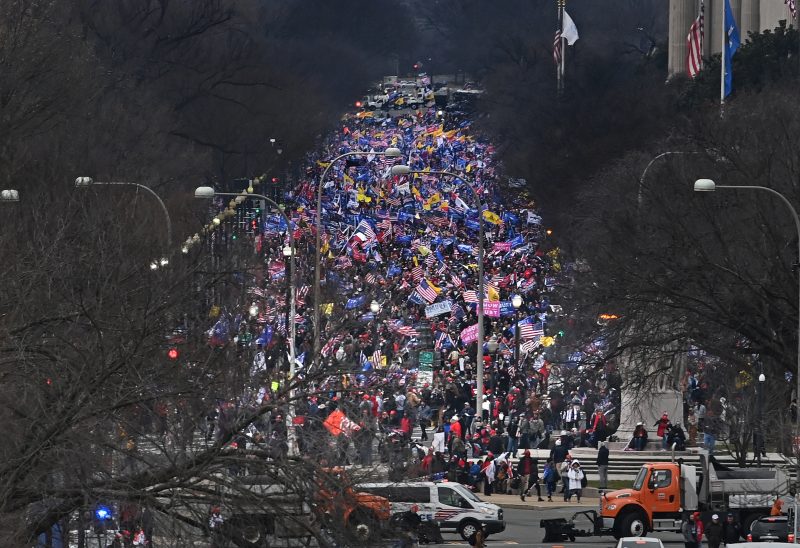There is no mystery about the Capitol riot. There is nothing intangible, no unseen engine for what occurred. There is no uncertainty about what happened and why.
But because everything about what unfolded on Jan. 6, 2021, implicates the cultural leader of the Republican Party — and because pretending that a mystery exists benefits him — we approach the third anniversary of that day with renewed efforts to rewrite its history.
Donald Trump lost the 2020 presidential election and very obviously refused to accept it. Any questions about the legitimacy of the vote — stoked by Trump for years — evaporated within weeks, if not days. Many of his allies shifted to vague arguments about how the system was working against him. But Trump didn’t. He argued that there was fraud covered up by Trump haters and, with increasing desperation, demanded that his supporters in Washington and elsewhere rise to his defense.
A few hours after a heated Oval Office argument in which his team tried to figure out how to retain power, he shared a post on social media calling for supporters to come to Washington on Jan. 6. The day’s protest, he promised, would “be wild.” This message itself comes up repeatedly when looking at the triggers for participants to be at the Capitol on that day.
Thousands came. Trump, still trying to figure out how to block the certification of Joe Biden’s election, gave a speech to the crowd making more false claims about fraud, including debunked ones, and encouraged people to march to the Capitol. They did. There was a riot. People died. Scores of police officers were assaulted. A few hours later, Trump’s loss was formalized.
In short, the day’s violence was carried out by Trump supporters and supporters of Trump’s politics. They were there not only because Trump specified that day and place as the location of a “protest” but because he’d relentlessly argued that a protest was needed. The intent was explicitly to challenge the results of the 2020 election. That Trump used the word “peacefully” once in his speech is no more exculpatory than the fact that thousands of Trump supporters weren’t violent and didn’t enter the Capitol. There was violence and there were violent actors; they were there because Trump refused to accept that voters had rejected him.
There was a point at which this might have understandably seemed like the coda to Trump’s tenure in politics. Trump lost the election and then stoked a violent response to the transfer of power. History books, if not Hollywood, suggest an epilogue in which he spends his remaining years exiled to the wilderness.
But he was never exiled. Less than two weeks after Trump’s departure from Washington, the leader of the House Republican conference, seeking to solidify his own power, paid the former president a sycophantic visit. Since 2015, Republicans had figured out that even valid criticisms of Trump could be pivoted to his and their advantage, and the riot was no different. So they did and, 1,000 days after the riot, Trump found himself the clear front-runner for the Republican 2024 presidential nomination.
This adds new urgency to efforts by Trump’s allies to neutralize his response to the 2020 election as a political issue. Trump’s opponents, including President Biden, have focused on Trump’s rejection of the election results — on his efforts to sideline democracy — as a central reason to oppose him in 2024. There’s evidence that many voters view 2024 through this lens. While many of the right’s defenses of Trump center on the short-term rewards of allying with his rhetoric, some of them are obviously more tactical.
These defenses take a number of forms.
The most deluded centers on the idea that the riot was not actually a function of Trump supporters or a desire to see Trump retain power. Two alternative culprits are generally proposed: federal agents or left-wing actors.
The latter idea was voiced immediately after the riot and was quickly debunked. But it lingers: Rep. Marjorie Taylor Greene (R-Ga.), who’s selling a book, told Donald Trump Jr. on a recent podcast that “nobody could tell me that those were Trump supporters” and that she believes “they were antifa — [Black Lives Matter] rioters.”
There’s no evidence of this at all. In fact, it defies any logic. For Greene, though, this is a long-held argument. During the riot itself, she texted White House Chief of Staff Mark Meadows to tell him that she and others “think they are Antifa … [d]ressed like Trump supporters.” Of course, that was about 90 minutes after she’d texted Meadows to exhort him to “[p]lease tell the President to calm people[.] This isn’t the way to solve anything.”
Greene’s response to Jan. 6 has been nearly as fungible and opportunistic as Trump’s. The rioters were antifa — except that those being held for committing acts of violence are also political prisoners being targeted for their Trump support by a nefarious Joe Biden.
This argument depends on a useful glossing over of what detainees actually did. Many of those who are in prison agreed to plea deals — which is to say they admitted guilt. Others were convicted of assaults on police officers. Others still were members of groups such as the Proud Boys or Oath Keepers who actively planned to disrupt the transition of power or to aid Trump in doing so. Lumping them all together as victims of a punitive state makes it much easier to ignore what they actually did.
It also makes it easier to cast Trump himself as the target of Deep State hostility. This has been his line for years, of course, but it gained new heft after the multiple indictments obtained against him this year. Many Trump supporters think he’s being unfairly targeted by leftist prosecutors; it’s hardly a stretch to suggest that this extends back to the weeks before Jan. 6, 2021. There’s no more evidence (much less logical reason) to support the idea that federal agents triggered the riot than there is to believe antifa did it. But every time someone is incorrectly identified as a federal agent or just asks questions about it, new space is introduced for Trump to argue that this is all meant to impede his power.
Elevation of doubt is at the heart of so much of this. You don’t need to know precisely what federal agent provocateur made Jan. 6 happen, but if you’re open to the idea that perhaps one did, you’re probably less compelled by arguments that Trump posed or poses a threat to democracy. If you are convinced that the House select committee investigating the riot was trying to take down Trump, it becomes easier to wave away the evidence presented that showed Trump’s culpability. And then, by extension, shrug at the similar or overlapping evidence from special counsel Jack Smith.
Elevation of doubt, in fact, offers its own political rewards. Speaker Mike Johnson (R-La.) recently announced that he would make available thousands of hours of security footage from the Capitol on that day — footage that has already been used to suggest both that nefarious, non-Trump actors were involved and that the day’s violence was overstated, given that much of the footage shows nothing but empty corridors. Cameras in the aft section of the Titanic would have shown tranquil scenes, too, until they were submerged.
Republican voices in opposition to reframing the aftermath of the 2020 election are becoming more scarce.
“Everyone who makes the argument that January 6 was an unguided tour of the Capitol is lying to America,” Rep. Ken Buck (R-Colo.) said on CBS’s “Face the Nation” on Sunday. “Everyone who says that the prisoners who are being prosecuted right now for their involvement in January 6, that they are somehow political prisoners or that they didn’t commit crimes, those folks are lying to America.”
Buck may feel more free to say these true things because he announced that he would not seek reelection. Former Wyoming representative Liz Cheney (R) was free to challenge Sen. Mike Lee’s (R-Utah) misinformation about Capitol security footage because she no longer needs to appeal to Republican voters. Lee does.
No one is happier to elevate doubt about the Capitol riot than Trump, of course. He’s floated pardoning those involved in the violence, reinforcing the idea that they — like him, of course! — are being unfairly targeted. He’s argued that the day’s events were not his fault and attacked critics who suggest otherwise.
Put another way: What Trump is doing now, 340-odd days before the 2024 general election, is amplifying self-serving falsehoods and finding a hungry audience for them. This is also precisely what he was doing in the weeks before the Capitol riot.








